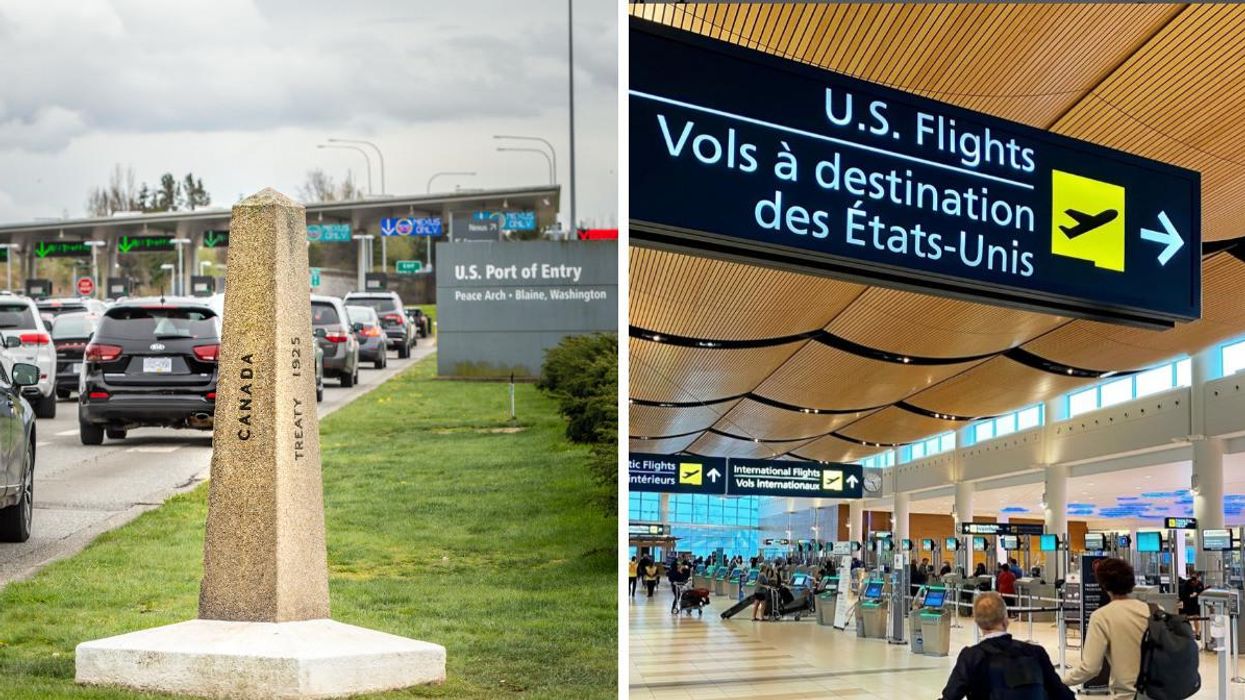Travel Restrictions Are Changing At The Canada-US Border & Here's Everything You Should Know
Get clued up if you're crossing the border via land, sea or air! 🇨🇦

Cars lining up at the Blaine border. Right: Passengers walk alongside a U.S. flights sign in Winnipeg Airport.
As of Monday, April 25, travel restrictions at the Canada-U.S. border will change, with updates impacting those crossing via land, sea or air.
Over the past week or so, both Canada and the United States have made announcements related to their border restrictions that could affect your trip.
Before you book a plane ticket, fuel your car or prepare to get on a boat, here's the latest when it comes to travelling to the U.S. and returning home.
Oh — and don't forget your mask, as the Canadian government is not scrapping its mask mandate for federally-operated forms of travel, including on planes and in airports.
Travelling via land
If you're planning to drive across the Canada-U.S. border, you'll need to be fully vaccinated against COVID-19 with a CDC-approved series of vaccines.
On April 21, the Department of Homeland Security (DHS) confirmed that the temporary vaccine requirements for non-American travellers would be extended.
It means Canadians travelling to the United States via land and ferry ports of entry must be fully vaccinated and provide proof of vaccination in order to enter the country.
This applies to all non-exempt travellers who are visiting, regardless of their reason for travel.
Fully vaccinated travellers driving into the United States from Canada are not required to show proof of a negative COVID-19 test. Similarly, fully vaxxed Canadians are not required to take a test upon their return to Canada.
This means fully vaxxed people are able to cross the land border without having to take a test of any kind.
Those considered to be partially vaccinated or unvaccinated will not be permitted to enter the U.S., unless they are exempt from requirements.
If you're travelling in your own car, you won't be required to wear a face covering on either side of the border, or while crossing, either .
However, if you're travelling via taxi or similar, you may be asked to wear a mask.
Travelling via air
To fly into the United States, those who are not U.S. citizens or U.S. immigrants must be considered fully vaccinated against COVID-19.
It means that in order to both board a plane in Canada and meet pre-entry requirements in the U.S., you must be fully vaxxed.
There are only limited exceptions.
Before being permitted entry into the States, passengers must provide a negative test result or documentation of recovery from COVID-19, too.
In the United States, federal mask mandates are no longer in effect in airports and on planes. However, the same does not apply in Canada. which makes it a little complicated.
Under Canada's own rules, all non-exempt passengers (regardless of vaccination status) must wear appropriate face coverings in all federally-operated airports and on all flights.
So, don't forget your mask if you're choosing to travel via air!
Travelling via sea
Canadians outside Canada: \n\nBe sure to regularly check our destination-specific #travel advice and advisories pages for important updates.— Travel.gc.ca (@Travel.gc.ca) 1648489500
Anybody entering the U.S. via ferry ports of entry must be fully vaccinated and be prepared to provide proof of their vaccination, if they are not a U.S. citizen or U.S. immigrant.
These restrictions apply regardless of whether an individual is travelling for essential or non-essential reasons.
COVID-19 testing is not required for entry via a land or ferry port of entry.
Children under 18 years old are exempt from the vaccination requirement at land and sea ports of entry.
What's changing in Canada?
As of Monday, April 25, a number of rules are changing for those entering or returning home to Canada.
Unvaccinated or partially vaccinated children aged between 5 and 11 (who are accompanied by a fully vaccinated guardian) will no longer be required to complete a pre-entry test.
However, these tests will still be necessary for partially vaccinated or unvaccinated travellers who are aged 12 and over.
As well, all fully vaxxed individuals will no longer have to provide a quarantine plan upon entry to Canada.
As of the same date, fully vaccinated travellers will no longer have to wear masks in public spaces for 14 days after arriving in Canada, report if they are developing symptoms, maintain a list of close contacts and more.
Before you get going, check out our Responsible Travel Guide so you can be informed, be safe, be smart, and most of all, be respectful on your adventure.
- The US Is Extending The Canada-US Border Vaccination ... ›
- Canada's Travel Rules Are Changing Once Again & Here's What ... ›
- Canada's Travel Restrictions Have Changed & Now It's Easier To Travel With Unvaccinated Kids - Narcity ›
- Cross-Border Shopping — 5 Things That Are Cheaper On Each Side Of The Canada-US Border - Narcity ›
